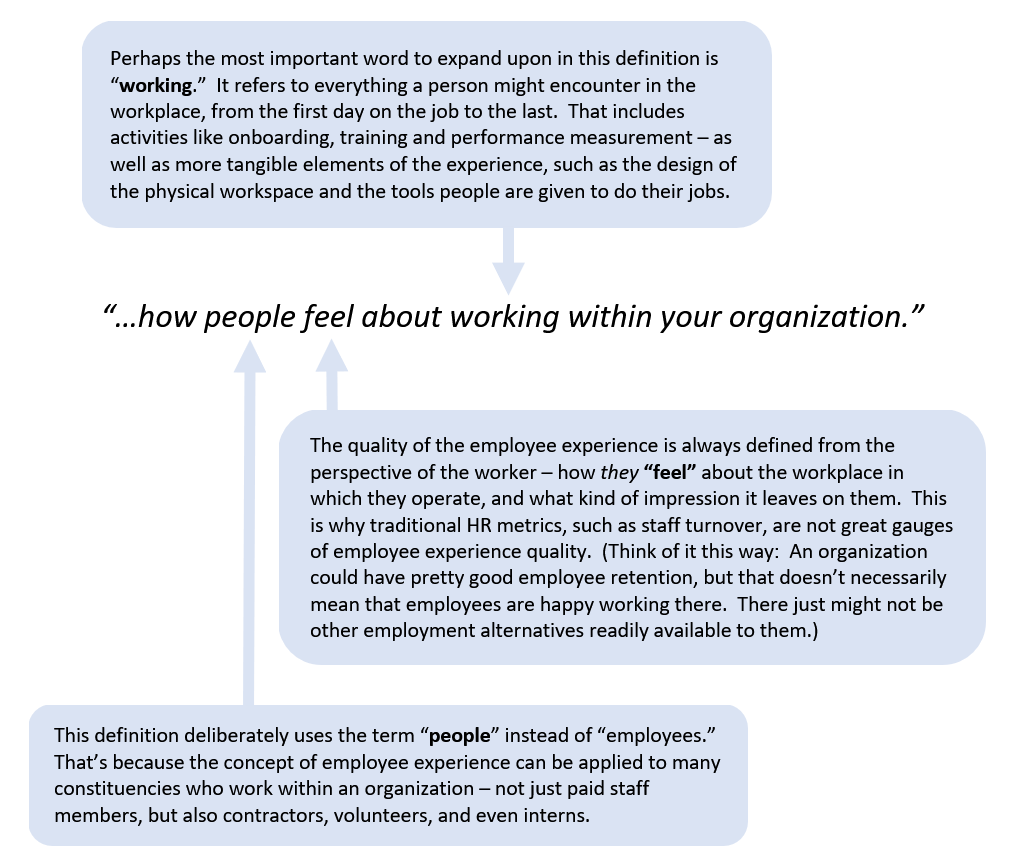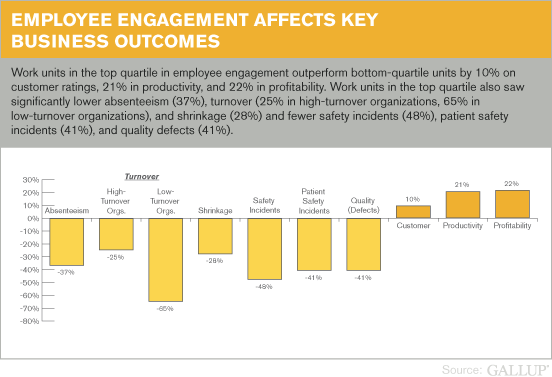
What is the Employee Experience?
The Employee Experience refers to how people feel about working within your organization. That’s Employee Experience in eight words, but there’s a lot to unpack in that definition:

Why does Employee Experience matter in business?
Think of it this way: If your employees aren’t happy about coming to work, and if they aren’t engaged while doing their work, then imagine the impact that will have on your business’ success. It’s the difference between people merely occupying their job and being truly committed to their job. That distinction is even more important when your employees have regular contact with customers, since their behavior is on display for all your patrons to see.
The fact is, the Customer Experience (CX) and the Employee Experience (EX) are inextricably linked.
 As I explained in my book FROM IMPRESSED TO OBSESSED: 12 Principles For Turning Customers And Employees Into Lifelong Fans, a great Customer Experience is like a well-choreographed performance. There’s an “onstage” component (everything your customers can see, feel or hear). But there’s also an equally important “backstage” component (everything going on behind-the-scenes that, while invisible to the customer, nonetheless influences the quality of the “performance”). That backstage component is what the Employee Experience is all about.
As I explained in my book FROM IMPRESSED TO OBSESSED: 12 Principles For Turning Customers And Employees Into Lifelong Fans, a great Customer Experience is like a well-choreographed performance. There’s an “onstage” component (everything your customers can see, feel or hear). But there’s also an equally important “backstage” component (everything going on behind-the-scenes that, while invisible to the customer, nonetheless influences the quality of the “performance”). That backstage component is what the Employee Experience is all about.
And it’s critical, because no matter what business you’re in, you can’t expect to deliver a great Customer Experience if your employees are not engaged, inspired and equipped to do so.
When the Employee Experience is positive, people are happier and more engaged in their jobs. That creates a more productive and effective workforce, comprised of individuals who want to invest discretionary effort to do a better job for their customers, colleagues and company.
These benefits are not theoretical. Numerous studies have demonstrated a link between employee engagement and business success, be it with regard to shareholder return or a host of other business measures.
The graphic below, from the Gallup organization (a leading researcher in this space) illustrates the broad impact that an engaging Employee Experience has on a company, from reducing absenteeism to raising productivity to improving profitability:

Does this just come down to paying employees well?
Compensation obviously plays an important role in making employees feel good about the job they do and the contributions they make. But it’s far from the only driver and, as many studies have shown, it’s rarely the most important.
Consider an individual who genuinely believes that they are well compensated by their employer. However, this person has a boss who is unsupportive and doesn’t help them advance their career. They have co-workers who are uncooperative and don’t take pride in their work. Moreover, this individual feels personally ill-equipped to do their job, because of the sub-par training they received and the poor tools and systems that their employer provides.
Would that individual be happy in their job, despite feeling good about their compensation? Would they be inclined to go the extra mile for the company and its customers?
Probably not, which is why it’s important to recognize that there are many factors that influence the quality of the Employee Experience, with compensation practices being just one of them.
So, what are the ingredients for a great Employee Experience?
If this isn’t just about compensation, then what is it about? Literally everything in the workplace.
Just as the Customer Experience is comprised of innumerable touchpoints and cues, so too is the Employee Experience.
It arguably starts before someone is even an employee. The Job Candidate Experience really establishes a foundation for what a new employee should expect from their employer. It sets the tone for the Employee Experience.
 Once the individual is on board, their Employee Experience is continuously shaped by every interaction they have in the workplace, by every environmental cue that surrounds them.
Once the individual is on board, their Employee Experience is continuously shaped by every interaction they have in the workplace, by every environmental cue that surrounds them.
Importantly, it’s not just about the benefits package and the employee perks. It’s not just about the physical workspace and the office location. All of those things matter, but so too do many other tangible and intangible components which are a part of any workplace, just a few of which are listed below:
- Onboarding techniques
- Training programs
- Job designs
- Performance metrics
- Reward and recognition programs
- Compensation practices
- Incentive programs
- Business policies
- Employee tools and technologies
- Workforce communications
- Cultural norms
- Leadership behaviors
If that looks like a daunting list… well, it is. And that’s precisely why a great Employee Experience can accord such significant, sustainable competitive advantage on a company. Aligning all of these components to create the ideal work environment isn’t easy, but the rewards are significant. That’s because companies which offer a great Employee Experience become the employers that everyone wants to work for. And, by virtue of attracting and retaining all the best people, these companies are then well-positioned to dominate their respective industries.
What can I personally do to create a better experience for my employees?
This is a really important question, because Gallup found that 70% of the variance in employee engagement scores can be traced back to the competence and effectiveness of an individual’s manager.
The answer lies in creating a work environment where people feel safe, supported and empowered – where they feel their manager (and the larger organization) genuinely values their contribution and sets them up for success.
That, of course, is a very short answer to a complicated question. Explore Watermark’s resources for improving employee engagement to get more specific tips for turning everyday employees into engaged brand ambassadors.
Jon Picoult is founder of Watermark Consulting, a customer experience advisory firm that helps companies impress customers and inspire employees, creating raving fans that drive business growth. Author of “FROM IMPRESSED TO OBSESSED: 12 Principles for Turning Customers and Employees into Lifelong Fans,” Picoult is an acclaimed keynote speaker, as well as an advisor to some of world’s foremost brands. Follow Jon on LinkedIn or Instagram, or subscribe to his monthly eNewsletter.